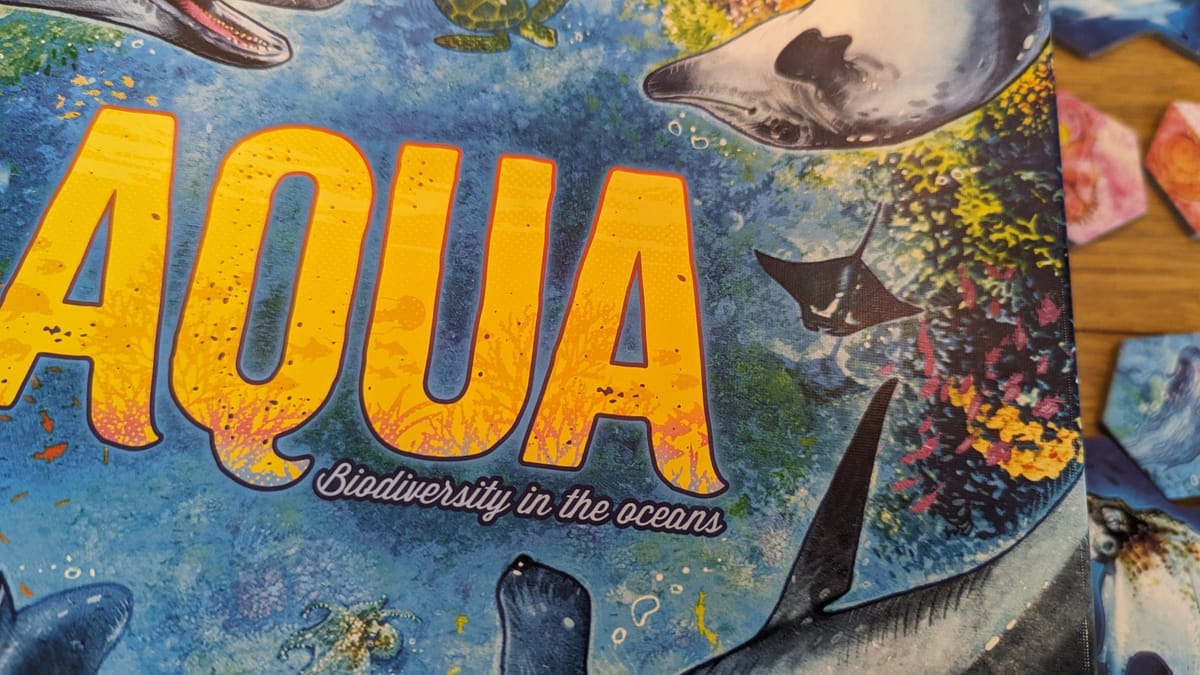
Spatial puzzle games have become intrinsic to the hobby. Ever since polyominoes caught fire with Patchwork, NMBR 9, and Feast for Odin, designers have been finding new ways to make our brains melt by putting cardboard bits together. Two years ago, Akropolis introduced stacking hexes, and now, Aqua has my brain oozing out my ears like it hasn’t before.

Aqua certainly starts off simple enough—every round consists of players drafting coral hex tiles and an adorable little sea snail we’ve named Gary. When it’s your turn, you pick a tile and place it so at least one border is adjacent to a like color, and if you’ve made a hex of one color, congrats, you’ve made a habitat, you can grab the small animal of that color and drop it on top for bonus points. If you’ve got a cluster of different small animals together, you can grab a large animal and drop it on top of them for mega bonus point super efficiency! If you don’t like any of the tiles on offer, you can take Gary instead of a tile on your turn to take the leftover tile after everyone else has had their pick to have first pick next round. If you’re super lucky and all the tiles work for you, you can just nab Gary to set yourself up for next round. I’m sure I’ve seen a similar mechanic in an open drafting game before, but I love how it smooths out the bumps from rounds where you’ve got an early pick but nothing good to use it on, which is usually a feel-bad moment.

So far, I’ve only explained the basic family game, which strips out ecosystems and reefs—additional scoring opportunities. Reefs are another great mechanic that transforms feel-bad bits into rewards: at the end of the game, every contiguous section of 4 or more of the same color counts as a reef and scores all adjacent small animals again. Love it. Ecosystems are specific additional conditions added to small animals during setup, like 3 points per small animal per dolphin, or an extra point for every adjacent small animal for the relevant small animal. Honestly, nothing too crazy, but it was nice to have the family mode there so I could bring my wife and parents up to speed in steps. There’s also the advanced mode, extra ecosystems that you shuffle in during setup. This posed my first issue with Aqua, as they add a fair amount of complexity and are all inherently weaker than the base game’s since they’re all additive instead of multiplicative, but then I approached it as the included mini expansion for people who play the base game to death that it is, and now I’m totally ok with it. Why the rules didn’t explicitly call it such is beyond me, but whatever. The only actual sticking point I’ve found is that the solo mode is rather lackluster, but who cares?
AQUA
Excellent
When you mix the adaptability of the core tile drafting and stacking with the phenomenal production and gorgeous art by Dutrait, Aqua is a better game than it has any business being. Some people may argue ironing out severely punishing poor placement and drafting detracts from the experience of those mechanics, but I find it nice to be rewarded when I'm good and have it be alright when I mess up a bit.
Pros
- Extremely approachable
- Great production
- Multiple mechanics assuage the feel-bad bits inherent to open drafting and tile-laying games
Cons
- The advanced mode should've just been called a mini expansion, I will die on this hill
- The solo mode is underwhelming
